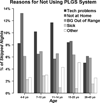In-home nighttime predictive low glucose suspend experience in children and adults with type 1 diabetes
- PMID: 27125223
- PMCID: PMC5086306
- DOI: 10.1111/pedi.12395
In-home nighttime predictive low glucose suspend experience in children and adults with type 1 diabetes
Abstract
Overnight predictive low glucose suspend (PLGS) reduces hypoglycemia across all ages; however, there are no reports on behavior or experience differences across age groups, especially in pediatrics. As run-in for a subsequent randomized clinical trial (RCT), 127 subjects (50% male) ages 4-45 yr utilized the experimental PLGS system nightly for 5-10 nights (PLGS active phase). We analyzed the number of blood glucose (BG) checks and boluses given per age group. During the subsequent 42 night RCT phase, we analyzed sensor use, skin reactions, errors, and reasons why the experimental system was not used. In 821 nights of active PLGS, subjects ages 4-6 yr (and their parents) tested BG levels 75% of nights compared with 65% of nights (7-10 yr), 53% of nights (11-14 yr), 33% of nights (15-25 yr), and 28% of nights (26-45 yr), respectively (p < 0.001). Likewise, youngest subjects (and parents) administered insulin boluses 56% of nights during active PLGS use compared with 48%, 33%, 20%, and 25%, respectively (p < 0.001). This was unrelated to study requirements. During the RCT phase, subjects 4-6 yr experienced more frequent and severe skin reactions (p = 0.02), while adult subjects (26-45 yr) wore individual sensors a median of 26 h longer than the youngest subjects (p < 0.001). Technical problems with the sensor (errors, miscalibrations, etc.), traveling, and BG levels >270 at bedtime (study requirement) were primary contributors to non-system use. Understanding the different use patterns and challenges in pediatrics and adolescence is needed to direct patient education to optimize use of PLGS and future artificial pancreas systems.
Keywords: artificial pancreas; pediatrics; type 1 diabetes.
© 2016 John Wiley & Sons A/S. Published by John Wiley & Sons Ltd.
Figures
References
-
- Kowalski A. Pathway to artificial pancreas systems revisited: moving downstream. Diabetes Care. 2015;38:1036–1043. - PubMed
Publication types
MeSH terms
Substances
Grants and funding
LinkOut - more resources
Full Text Sources
Other Literature Sources
Medical
Research Materials


